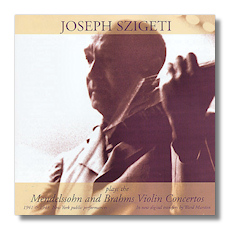
The Internet's Premier Classical Music Source
Related Links
-
Brahms Reviews
Mendelssohn Reviews - Latest Reviews
- More Reviews
-
By Composer
-
Collections
DVD & Blu-ray
Books
Concert Reviews
Articles/Interviews
Software
Audio
Search Amazon
Recommended Links
Site News
 CD Review
CD Review
Joseph Szigeti

1941 & 1948 New York Public Performances
- Felix Mendelssohn: Violin Concerto in E minor, Op. 64
- Johannes Brahms: Violin Concerto in D, Op. 77 *
Joseph Szigeti, violin
"Philharmonic-Symphony Orchestra"/Bruno Walter
* "Philharmonic-Symphony Orchestra"/Dimitri Mitropoulos
Music & Arts CD-1197 ADD monaural 67:55
The 1940s were a remarkable decade for violin-playing. Heifetz and Menuhin, at the top of their respective forms, were particularly prominent during and after World War Two, but we should not forget Joseph Szigeti (1892-1973), who can be spoken of in the same breath, even if he is less famous than the other two today.
Szigeti studied with Jenő Hubay, who in turn studied with the great Joseph Joachim. He became a Wunderkind musician, specializing in flashy showpieces and salon-ish repertoire. At one point he even played in a circus (albeit under a different name)! His artistic maturation was aided by long-standing friendships with Ferruccio Busoni and Béla Bartók. In 1925 he was invited to the United States by Leopold Stokowski, and in 1940 he came to America to stay, although he didn't receive citizenship until 1951. He continued to perform until 1960, when arthritis began to affect his playing. He then settled in Switzerland. After his retirement as a performer, he continued to teach. His pupils included Kyung-Wha Chung. An interesting bit of Szigeti trivia is that he narrowly avoided almost certain death in several plane crashes by giving up his seat or changing his travel plans at the last minute. For example, a 1942 flight he was to have taken out of Albuquerque crashed, killing all passengers and crew aboard. Among the victims was movie actress Carole Lombard.
This CD contains two live performances from the 1940s. The Mendelssohn dates from February 2, 1941, and the Brahms from October 24, 1948. Given the orchestra and the conductors involved, I assume that the concert location in both instances was Carnegie Hall.
Commentators often cite Szigeti's distinctive style. Around 1950 (that is to say, later than either of these performances), his playing acquired a heavy, wide vibrato. However, apart from that, there doesn't seem to be much of a consensus as to what was distinctive about it. In his notes to the present CD, Abram Chipman suggests that Szigeti had a lot of "ingredients" from which to choose. From one phrase to the next, he could create a noticeably different sound. In my experience, Szigeti is never flashy. Earlier recordings (which I have not heard) might prove me wrong on that point. Instead, he always turns in a thoughtful, emotionally involved reading that is just on the good side of self-effacing. In his maturity, he also used portamenti more than most of his peers.
The Brahms is worth the price of admission here. Szigeti made three commercial recordings of this work – in 1928 with Harty, in 1945 with Ormandy, and in 1959 with Menges. The vibrato of his later years is not much in evidence here, and in Mitropoulos, he is working with a conductor who has a point of view about the music (and it is a valid one), and who also is in sympathy with his soloist. It's a warm, noble reading, and one that finds Szigeti in great shape, in terms of technique.
The Mendelssohn, although it is the earlier performance, sounds like the work of an older Szigeti. Almost from the outset, there are more than occasional problems with intonation, particularly in the first movement. Music which ideally should sound spontaneous and effortless sometimes sounds labored here. In short, this is Mendelssohn with a sense of struggle added in. It is not a bad performance, but it demonstrates how variable Szigeti could be – even from one moment to the next.
The new digital remasterings by Ward Marston are excellent – practically of studio quality. Especially in the Brahms, one is amazed to think that almost 60 years have gone by. Marston and Music & Arts have retained the voice of the radio announcer at the beginning and end of the Brahms – a nice nostalgic touch for what is a very nostalgic release.
Copyright © 2007, Raymond Tuttle





















